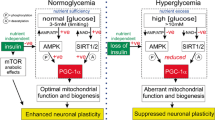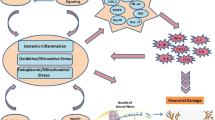Abstract
The data of recent studies of fundamental mechanisms underlying the development of diabetic neuropathies are summarized in the Review. The importance of a sorbitol-polyol pathway of glucose metabolism, as well as the roles of production of peroxide radicals and activation of the processes of non-enzymatic glycosilation in the nerve cells are analyzed. Special attention is paid to the roles of growth factors in morphological modifications of the neuronal structures and to that of intracellular signalization in functional disturbances in the nerve cells. Changes in intracellular homeostasis of Ca ions are of considrable importance for the development of peripheral diabetic neuropathies.
Similar content being viewed by others
References
M. I. Balabolkin,Diabetes Mellitus [in Russian], Meditsina, Moscow (1994).
J. Pirart, “Diabetes mellitus and its degenerative complications: a prospective study of 4,400 patients observed between 1947 and 1973,”Diabetes Care,1, 168–188 (1978).
A. J. Vinik, F. J. Linzze, M. T. Holland, et al., “Diabetic neuropathies,”Diabetes Care,15, 1926–1975 (1992).
A. A. F. Sima, P. K. Thomas, D. Ishii, et al., “Diabetic neuropathy,”Diabetologia,40, B74-B77 (1997).
D. A. Green, A. A. F. Sima, J. W. Albers, et al., “Diabetic neuropathy,” in:Diabetes Mellitus, Theory and Practice, H. Rifkin and D. Portae (eds.), Elsevier, New York, Amsterdam, London (1993), pp. 710–756.
P. J. Oates, “The polyol pathway—a culprit in diabetic neuropathy?,”Neurosci. Res. Commun.,21, No. 1, 33–40 (1997).
G. Said, C. Goulon-Gonan, G. Slama, et al., “Severe earlyonset polyneuropathy in insulin-dependentdiabetes mellitus: a clinical and pathological study,”New Eng. J. Med.,26, 1257–1263 (1992).
A. A. F. Sima, V. Nathaniel, V. Bril, et al., “Histopathological heterogeneity of neuropathy in insulin-dependent and non-insulin-dependent diabetes and demonstration of axo-glial dysjunction in human diabetic neuropathy,”J. Clin. Invest.,81, 349–364 (1988).
D. D. Sandeman, A. C. Shore, and Y. E. Tooke, “Relation of skin capillary pressure in patients with insulin-dependentdiabetes mellitus to complications and metabolic control,”new Eng. J. Med.,327 760–764 (1992).
A. C. Shore, A. J. Jaap and J. E. Tooke, “Capillary pressure in patients with NIIDM,”Diabetes,43, 1198–1202 (1994).
A. A. F. Sima, W.-X. Zhang, W. J. Tze, et al., “Diabetic neuropathy in induced diabetic rat and effect of allogenic islet transplantation: morphometric analysis,”Diabetes,37, 1129–1136 (1988).
P. Sidenius and J. Jacobsen, “Reversibility and preventability of the decrease in slow axonal transport velocity in experimental diabetes,”Diabetes,31, 689–693 (1982).
Y. R. Larsen and P. Sidenius, “Slow axonal transport of structural polypeptides in rat, early changes in streptozotocin diabetes and effect of insulin treatment,”J. Neurochem,52, 390–401 (1989).
R. Watanabe, “Molecular biological study on pathogenesis of diabetic neuropathy: alterations in mRNA expression of aldose reductase and axonal cytoskeletal protein,”Hirosaki Med. J.,45, S196-S204 (1993).
P. K. Thomas, D. W. Wright, and E. Tzebelikos, “Amino acid uptake by dorsal root ganglia from STZ-diabetic rats,”J. Neurol. Neurosurg. Psychiat.,47, 912–916 (1984).
V. J. Brewster, L. T. Diemel, L. Mohiuddin, and D. R. Tomlinson, “Diabetic neuropathy, nerve growth factor and other neurotrophic factors,”TINS,17, No. 8, 321–325 (1994).
V. Faradji and J. Sotelo, “Low serum levels of nerve growth factor in diabetes neuropathy,”Acta Neurol. Scand.,81, 402–406 (1990).
S. Yagihashi, “Pathology and pathogenetic mechanisms of diabetic neuropathy,”Diabetes/Met. Rev.,11, No. 3, 193–225 (1995).
O. Kasayama and T. Oka, “Impaired production of nerve growth factor in the submandibular gland of diabetic mice,”Am. J. Physiol.,257, E400-E404 (1989).
M. J. Stevens, E. L. Feldman, and D. A. Greene, “The aetiology of diabetic neuropathy: the combined roles of metabolic and vascular defects,”Diabetic Med.,12, 566–579 (1995).
P. Kostyuk and A. Verkhratsky,Calcium Signalling in the Nervous System, Wiley and Sons, Chichester, New York, Brisbane, Toronto, Singapore (1995).
L. J. Sake and A. F. Eakes, “Epidermal growth factor stimulates the production of phosphatidylinositol monophosphate and the breakdown of polyphosphoinostides in A431 cells,”J. Biol. Chem.,262, 1644–1651 (1987).
S. A. Rogers and M. R. Hammerman, “Insulin-like growth factor II stimulates production of inositoltrisphosphate in proximal tubular basolateral membrane from canine kidney,”Proc. Natl. Acad. Sci. USA,85, 4037–4041 (1988).
R. M. Lindsay and M. Harmar, “Nerve growth factor regulates expression of neuropeptide's genes in adult sensory neurons,”Nature,337, 362–364 (1989).
R. M. Lindsay, C. Locket, J. Stenberg, et al., “Neuropeptide expression in cultures of adult sensory neurons; modulation of substance P and calcitonin-gene-related peptide levels by nerve growth factors,”Neuroscience,33, 53–65 (1989).
L. T. Diemel P. Fernyhough, K. Maeda, et al., “Nerve growth factor (NGF) treatment normalizes NGF and neuropeptides in sciatic nerve of streptozotocin-diabetic rats without affecting motor nerve conduction or nerve laser-Doppler flux,” in:Diabetic Neuropathy, New Concepts and Insights, N. Hotta, D. Greene, J. D. Ward, et al. (eds.), International Congress Sereis 1084, Excerpta Medica, Elsevier, Amsterdam, Lausanne, New York, Oxford, Shannon, Tokyo (1995), pp. 169–173.
S. M. Grain, “Neurotrophic factors in diabetic neuropathy,”TINS,18, No. 1, 15–16 (1995).
J. W. Griffin, R. Goerge, C. Lobata, et al., “Macrophage response and myelin clearance during Wallerian degeneration: relevance to immune mediated demyelinization,”J. Neuroimmunol.,40, 153–166 (1992).
V. H. Perry and M. C. Brown, “Role of macrophages in peripheran nerve degeneration and repair,”BioEssays,14, 401–406 (1992).
A. A. F. Sima, J. Levitan, H. Ristic, et al., “Nerve fiber regeneration in the spontaneously diabetic BB/W rat,” in:Diabetic Neuropathy, New Concepts and Insights N. Hotta, D. A. Greene, J. D. Ward, et al. (eds.), International Congress Series 1084, Excerpta Medica, Elsevier, Amsterdam, Lausanne, New York, Oxford, Shannon, Tokyo (1995), pp. 27–36.
C. L. Crawford and M. J. Hobbs, “Neurotrophic factors in diabetic neuropathy,”TINS,18, No. 1, 15 (1995).
D. A. Green, S. A. Lattimer, and A. A. F. Sima, “Tissue-specific metabolic alterations in the pathogenesis of diabetic peripheral neuropathy,” in:Tissue Specific Alterations in Diabetes, F. Belfore, G. M. Mollinatti, and G. U. Reaven (eds.), Karger, Basel (1990).
T. C. Hohman and H. M. Kwon, “Two separate mechanisms for the glucose inhibition of myoinositol transport,” in:Diabetic Neuropathy, New Concepts and Insights, N. Hotta, D. Greene, J. D. Ward, et al. (eds.), International Congress Series 1084, Excerpta Medica, Elsevier, Amsterdam, Lausanne, New York, Oxford, Shannon, Tokyo, (1995), pp. 43–58.
J. Kim, E. H. Rushovich, T. P. Thomas, et al., “Diminished specific activity of cytosolic protein kinase C in sciatic nerve of streptozotocin-diabetic rats and its correction by dietary myo-inositol,”Diabetes,40, 1545–1554 (1991).
D. A. Greene, S. A. Latimer, and A. A. F. Sima, “Are disturbances of sorbitol phosphoinositide and Na+/K+-ATPase regulation involved in pathogenesis of diabetic neuropathy?,”Diabetes,37, 688–693 (1988).
R. P. Rubin,Calcium and Cellular Secretion, Plenum Press, New York, London (1982).
C. D. Ferris, and S. H. Snyder, “Inositol phosphate receptors and calcium disposition in the brain,”J. Neurosci.,12, 1567–1574 (1992).
T. Inogushi, R. Battan, E. Handler, et al., “Preferential elevation of protein kinase C isoform βII and dicylglycerol levels in the aorta and heart of diabetic rats,”Proc. Natl. Acad. Sci. USA,89, 11059–11063 (1992).
H. Ishii, M. R. Jirousek, D. Koya, et al., “Amelioration of vascular dysfunction in diabetic rats by an oral PKC B inhibitions,”Science,272, 728–731 (1996).
T. Y. Goraya, P. Wilkins, and J. G. Douglas, “Signal transduction alterations in peripheral nerves from streptozotocin-induced diabetic rats,”J. Neurosci.,41, 518–525 (1995).
N. E. Cameron and M. A. Cotter, “Mechanisms underlying impaired peripheral nerve perfusion and endoneural oxygenation in experimental diabetes: potential treatment strategies,” in:Diabetic Neuropathy, New Concepts and Insights, N. Hotta, D. Greene, J. D. Ward, et al. (eds.), International Congress Series 1084, Excerpta Medica, Elsevier, Amsterdam, Lausanne, New York, Oxford, Shannon, Tokyo (1995), pp. 3–15.
A. W. Norman and G. Litwack,Hormones, Acad. Press, San-Diego, London, Boston, New York, Sydney, Tokyo, Toronto (1997).
M. J. Stevens, “Nitric oxide as a potential bridge between the metabolic and vascular hypothesis of diabetic neuropathy,”Diabetic Med.,12, 292–295 (1995).
L. Sobrevia and G. E. Mann, “Dysfunction of the endothelial nitric oxide signalling pathway in diabetes and hyperglycemia,”Exp. Phsyiol.,82, 423–452 (1997).
A. Zahadnikova and O. Krizanova, “Nitric oxide and its effects on the calcium transport system in the myocardium,”J. Physiol. Biophys.,16, 197–215 (1997).
M. Nakane, L. Mitchel, U. Forstermann, et al., “Phosphorylation by calcium/calmodulin-dependent protein kinase II and protein kinase C the activity of nitric oxide synthase,”Biochem. Biophys. Res. Commun,180, 1396–1402 (1991).
K. S. Murthy, J. G. Jim, and G. M. Makhlouf, “Inhibition of nitric oxide synthase activity in dispersed gastric muscle cells by protein kinase C,”Am. J. Physiol.,266, No. 29, G161-G165 (1994).
D. A. Greene and M. J. Stevens, “Interaction of metabolic and vascular factors in the pathogenesis of diabetic neuropathy,” in:Diabetic Neuropathy, New Concepts and Insights, N. Hotta, D. Greene, J. D. Ward, et al. (eds.), International Congress Series, 1084, Excerpta Medica, Elsevier, Amsterdam, Lausanne, New York, Oxford, Shannon, Tokyo (1995), pp. 37–43.
P. A. Low, “Recent studies on experimental diabetic neuropathy,” in:Diabetic Neuropathy, New Concepts and Insights, N. Hotta, D. Greene, J. D. Ward, et al. (eds.) International Congress Series 1084, Excerpta Medica, Elsevier, Amsterdam, Lausanne, New York, Oxford, Shannon, Tokyo (1995), pp. 17–23.
T. Ohkuwa, Y. Sato, and M. Naoi, “Hydroxyl radical formation in diabetic rats induced by streptozotocin,”Life Sci. 56, No. 21, 1789–1798 (1995).
M. Gavella, “Oxidative stress and role of antioxidants in male infertility,”Diabetologia Croatica,26, No. 2, 65–68 (1997).
B. S. Krystal, C. T. Jackson, and H. Y. Chung, “Defects at center P underlie diabetes-associated mitochondrial dysfunction,”Free Rad. Med.,22, No. 5, 823–833 (1997).
M. Brownlee, “Advanced products of nonenzymatic glycosylation and the pathogenesis of diabetic complications,” in:Diabetes Mellitus, Theory and Practice, H. Rifkin and D. Portae (eds.), Elsevier, New York, Amsterdam, London (1993), pp. 279–292.
S. Yagihashi, M. Kamijo, Y. Ido, et al., “Effects of long-term aldose reductase inhibition on development of experimental diabetic neuropathy: ultrastructural and morphometric studies on sural nerve in streptozotocin-induced diabetic rats,”Diabetes,39, 690–696 (1990).
N. A. Cullum, J. Mahon, K. Stringer, et al., “Glycation of rat sciatic nerve tubulin in experimentaldiabetes mellitus, “Diabetologia,43, 387–389 (1991).
M. Cohen,Diabetes Glycosylation Measurement and Biologic relevance, Springer-Verlag, New York, Berlin, Heiderberg, Tokyo (1986).
K. Sugimoto and S. Yagihashi, “In situ localization of early and advanced glycation products in the peripheral nerve of streptozotocin diabetic rats,”Diabetes,44, Suppl. 1, 11A (1995).
G. Biessels and W. H. Gispen, “The calcium hypothesis of brain aging and neurodegenarative disorders: significance in diabetic neuropathy,”Life Sci.,59, 379–387 (1996).
E. Carstens, “Neural mechanisms of hyperalgesia: peripheral or central sensitization?”,NIPS,10, 260–265 (1995).
E. Kostyuk, N. Pronchuk, and A. Shmigol, “Calcium signal prolongation in sensory neurones of mice with experimental diabetes,”neuroReport,6, 1010–1012 (1994).
K. E. Hall, A. A. F. Sima, and J. W. Wiley, “Voltage-dependent calcium currents are enchanced in dorsal root ganglion neurones from the Bio/Bred/Worchester diabetic rat,”J. Physiol.,486, No. 2, 313–322 (1995).
K. E. Hall, A. A. F. Sima, and J. W. Wiley, “Opiate-mediated inhibition of calcium signalling is decreased in dorsal root ganglion neurons from diabetic BB/W rat,”J. Clin. Invest.,97, No. 5, 1165–1172 (1996).
Author information
Authors and Affiliations
Rights and permissions
About this article
Cite this article
Kostyuk, E.P. Cellular mechanisms underlying the development of diabetic neuropathies. Neurophysiology 30, 120–127 (1998). https://doi.org/10.1007/BF02463061
Received:
Issue Date:
DOI: https://doi.org/10.1007/BF02463061




